For amateur astronomers, spring is considered the best time to observe galaxies. There are many of them in the April sky; the Virgo Cluster alone is worth a look! And in general, the first days of April, while the Moon is in the thin crescent phase, will be quite favorable for observing deep space objects. Enthusiasts will be able to find many objects in the famous Messier object, which includes a variety of star clusters, galaxies, and nebulae, overnight.
Most planets will be in the morning sky in April, but Jupiter, Mars, and Uranus are still available for evening observations. Venus is slowly becoming brighter, and in the last decade of the month, it will again be visible to the naked eye in the daytime sky.
At the end of the month, the early birds will be pleased with a trine: Venus – the old crescent – Saturn, especially since Venus will reach its peak brightness. Around the same time, Mercury will have its maximum western elongation, but it will be surprisingly unlucky – the planet will rise almost simultaneously with the Sun.
April will also be marked by the first relatively powerful spring meteor shower, the Lyrids. Although it is far inferior to the Perseids, Geminids, and Quadrantids, it is still nice to know that you can see the particles of comet C/1861 G1 (Thatcher), which humanity has not seen for more than 160 years, burning up in the Earth’s atmosphere.
List of events
👀 🔭 📷 April 1 – the New Moon (14%) will be close to the Pleiades.
👀 🔭 📷 April 2 – Moon (23%) in conjunction with Jupiter (-2.1m), the exact time of conjunction is April 3 at 00:30 a.m. GMT (7:30 p.m. EST), when there will be 4.6° between the celestial bodies, but for Ukraine they will already be below the horizon.
👀 🔭 📷 April 5 – the Moon (47%) will be in conjunction with Mars, 1.5° north of it; the time of conjunction is 9:13 p.m. GMT (4:13 p.m. EST).
👀 🔭 📷 April 13 – a full moon; the exact time – 01:22 a.m. GMT (8:22 p.m. EST).
👀 🔭 📷 April 21 – Mercury (+0.3m) will be at its greatest western elongation, moving 27.4° away from the Sun. The plane of Mercury’s orbit is quite close to the ecliptic, and in the Northern Hemisphere, the angle between the ecliptic and the horizon is very small in the morning spring sky. Therefore, despite the seemingly large angular distance from the Sun, it will be very difficult to observe Mercury at this maximum elongation – it rises above the horizon shortly before the Sun.
👀 🔭 📷 April 22 – the maximum of the Lyrid meteor shower, with a ZHR of 18. The activity of the shower lasts from April 14 to April 30.
👀 🔭 📷 April 24 – Venus reaches its brightest (-4.8m) in the morning sky.
👀 🔭 📷 April 25 – the Moon, Venus, Saturn, and Neptune are in a close alignment low above the eastern horizon. At 2:20 a.m. GMT (9:20 p.m. EST), the Moon (10%) conjoins Saturn (+1.2m), at 3:31 a.m. GMT (10:31 p.m. EST) – Venus (-4.8m), and at 9:29 a.m. GMT (4:29 a.m. EST) – Neptune (+7.9m). But the best time to observe this complex is about 30-35 minutes before sunrise. The event is better observed in the south.
👀 🔭 📷 April 27 – a new moon; the exact time is 7:31 p.m. GMT (2:31 p.m. EST).
👀 🔭 📷 April 29 – conjunction of Venus (-4.7m) and Saturn (+1.2m), the exact time of the conjunction is 10:46 p.m. GMT (5:46 p.m. EST), when there will be 3.7° between the planets, but for Ukraine they will be below the horizon; the event is equally well observed at dawn on April 28 and 29.
👀 🔭 📷 April 30 – conjunction of the Moon (12%) with Jupiter (-2.0m), the exact time of the conjunction is 7:06 p.m. GMT (2:06 p.m. EST), the distance between the bodies will be 4.6°.
A detailed overview of the most interesting events
April 1: conjunction of the Moon with the Pleiades and coverage
On the evening of April 1, it will be possible to see the young (16%) Moon slowly approaching the Pleiades diffuse cluster. When the two objects are below the horizon for observers in Ukraine, the Moon will pass directly over the star cluster, gradually covering its stars one by one. This event is called occultation.
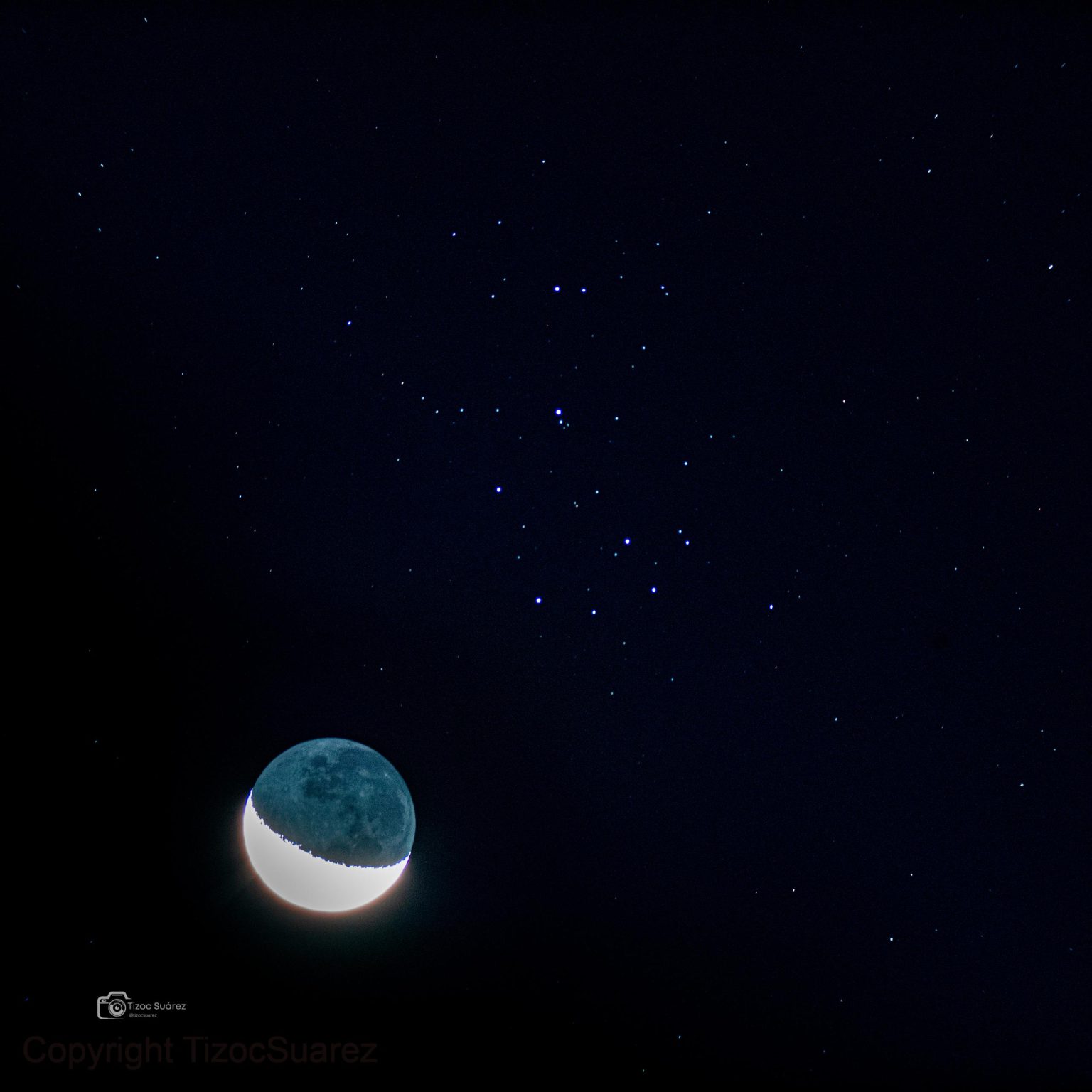
The Pleiades (M45, or Seven Sisters) is the most prominent star cluster in the northern sky, located in the constellation Taurus. It resembles a tiny ladle, which is why beginners often confuse it with the Ursa Minor. The naked eye can usually see only 6-9 stars in the cluster, but with binoculars or a small telescope, at least dozens of them are visible. In fact, according to various estimates, the Pleiades include up to 3000 stars.
The most favorable conditions for observing the Pleiades’ coverage by the Moon will be in Western Europe. In the United States, the event will take place mostly in the daytime sky. When it gets dark enough, the Moon will have already left the cluster.
April 22: maximum of the Lyrid meteor shower
The Lyrids are the first relatively powerful meteor shower of the spring and the first to be observed after a long break following the spectacular Quadrantids of early January. The shower starts on April 14 and lasts until April 30, with a maximum on April 22.
The expected ZHR at the maximum is about 18. But it is worth remembering that this value corresponds to the number of meteors that an observer can see in a perfectly dark, completely open sky, provided that the radiant of the shower is at its zenith. The actual number of meteors will be much lower due to the much lower altitude of the constellation Hercules, where the radiant is located for most of the period of the shower’s activity, and also due to light pollution.
The best time to observe is in the second half of the night, approximately from midnight to morning. According to the International Meteor Organization, the maximum occurs on April 22 at 1:30 p.m. GMT (8:30 a.m. EST), so expect approximately the same activity on the nights of April 21-22 and 22-23. The old crescent rising in the early morning will not prevent you from enjoying the show. The lyrids are not very fast – the particles enter the atmosphere at a speed of 47 km/s.
The Lyrid meteor shower is associated with the comet C/1861 G1 (Thatcher), which was discovered by amateur astronomer Albert Thatcher. This comet has a very long orbit and returns to the Sun approximately every 422 years. Its next appearance is expected in 2283. In the meantime, every year, the Earth crosses its orbit, and we can observe how fragments of the comet scattered along its trajectory burn up in our atmosphere.
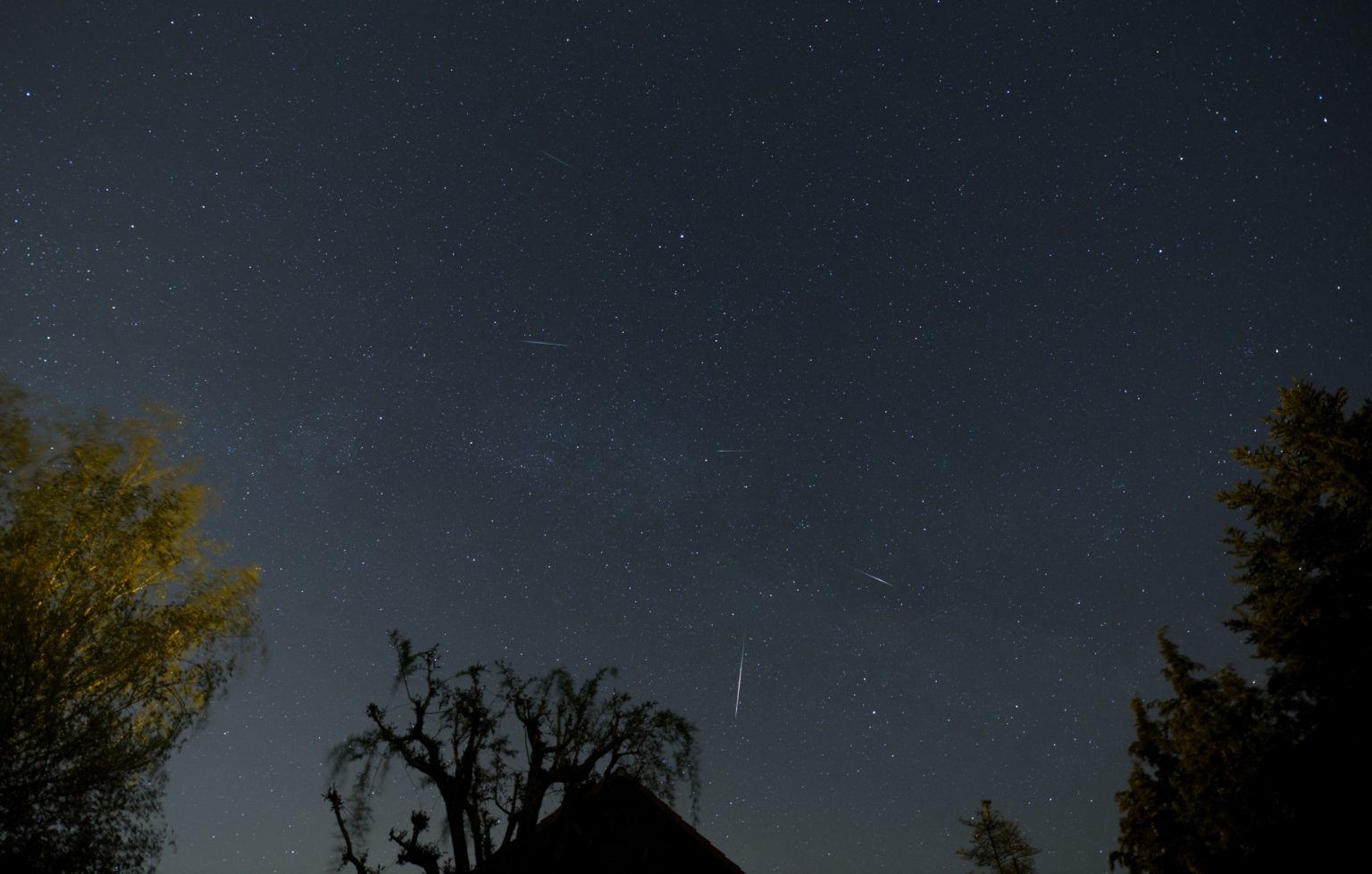
April 24: Venus reaches its brightest in the morning sky
In mid-February, Venus delighted us with its extraordinary brightness in the evening sky. On March 23, the “Evening Star” passed between the Earth and the Sun (lower conjunction), and now it is gradually “overtaking” the Sun as the “Morning Star”, so we will see more and more of the planet illuminated by the Sun. However, the conditions for observations in the Northern Hemisphere will not be very good, as Venus is quite low above the horizon just before sunrise.
As the phase grows, Venus’s brightness also increases quite rapidly, and on April 24, it will reach a maximum value of -4.8m. Just before the rising of our daylight, the planet will be at an altitude of 14°. The high brightness will allow you to find Venus in the daytime sky (if you have sharp eyesight). The easiest way to do this will be on April 25, when the old crescent will be close to it, which will help focus your vision and find the planet.
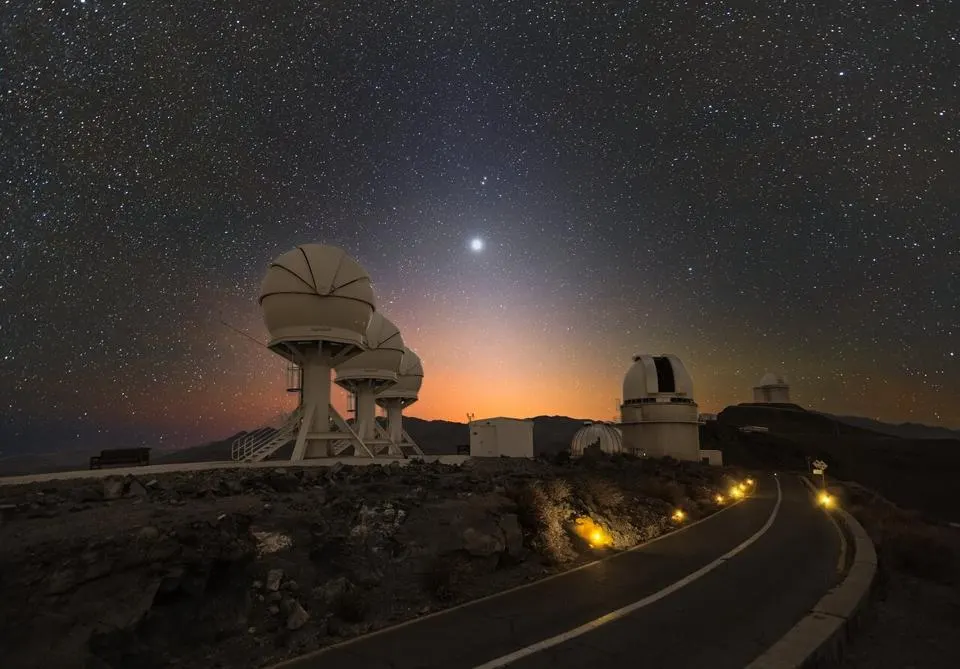
April 25: Old crescent, Venus, Saturn, and Neptune in close alignment
This event is worth setting your alarm for 3 a.m. GMT (10:00 p.m. EST)! You will be rewarded with incredible beauty: the thin crescent of the old crescent will be almost exactly under the extremely bright Venus. Below it, you will be able to see Saturn, whose rings will appear as a thin strip. If you use binoculars or a telescope with a low magnification, you will be able to see the Moon and Saturn in the same field of view.
East of Saturn, you can try to find another planet, Neptune. But it’s worth noting that this will be a rather difficult target for experienced telescope owners.
The further south you are, the better the observing conditions will be. Residents of the Southern Hemisphere will be able to easily find Mercury, which will undergo its greatest western elongation on the 21st, so it will be the best time to observe it. The Northern Hemisphere will be less fortunate, as the fastest planet in the Solar System will be too low above the horizon. The difference in visibility conditions is because, during sunrise, the ecliptic crosses the horizon plane at different angles, depending on your geographic location.
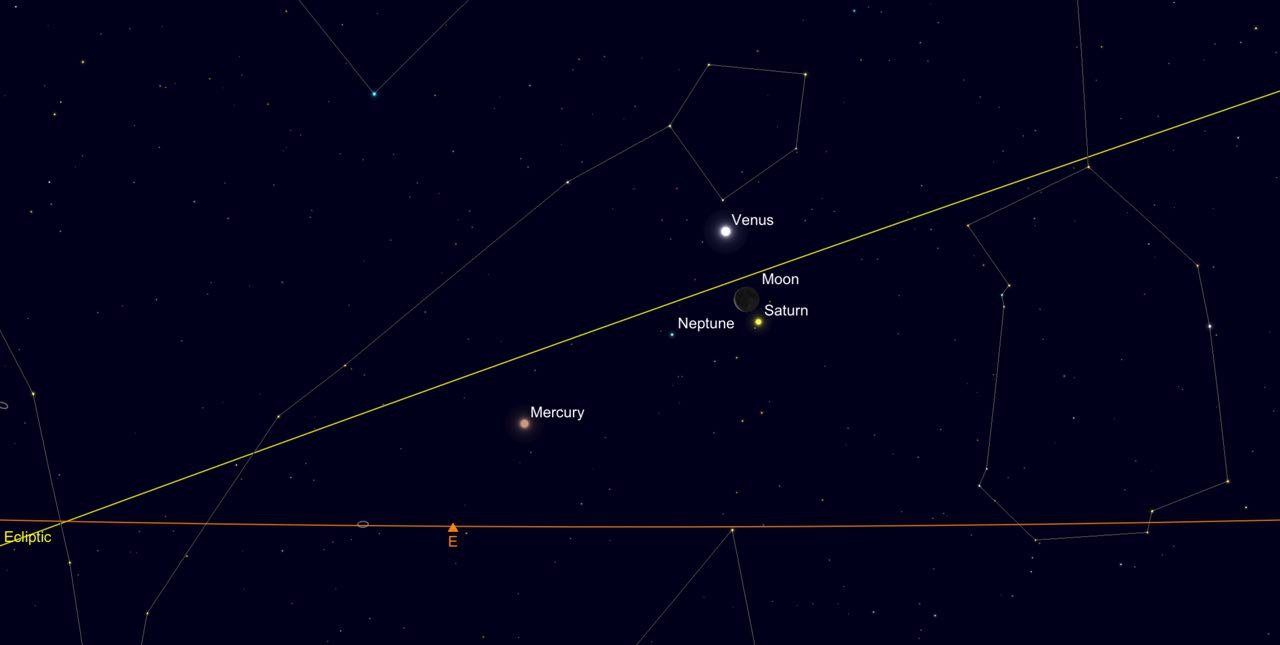
Source: SkySafari virtual planetarium
April 27: New Moon – time for distant galaxies
Both at the beginning of the month and at the end, we recommend that you pay attention to several galaxies that will be in particularly good positions for observing. To find these galaxies, you will need a telescope, preferably one with a diameter of 150 mm or more. Another condition is the darkest possible sky.
The anatomy of the human retina has certain nuances: cones – photoreceptors that perceive color – are concentrated in the center, while rods – photoreceptors responsible for low-light vision – are distributed mostly along the periphery. Unlike not very sensitive cones, rods need only 2-3 photons to be excited. Therefore, when observing such faint ghostly objects as galaxies, you should actively use your peripheral vision. Try looking at the galaxy not directly but slightly to the side. Surprisingly, you will see the object better.
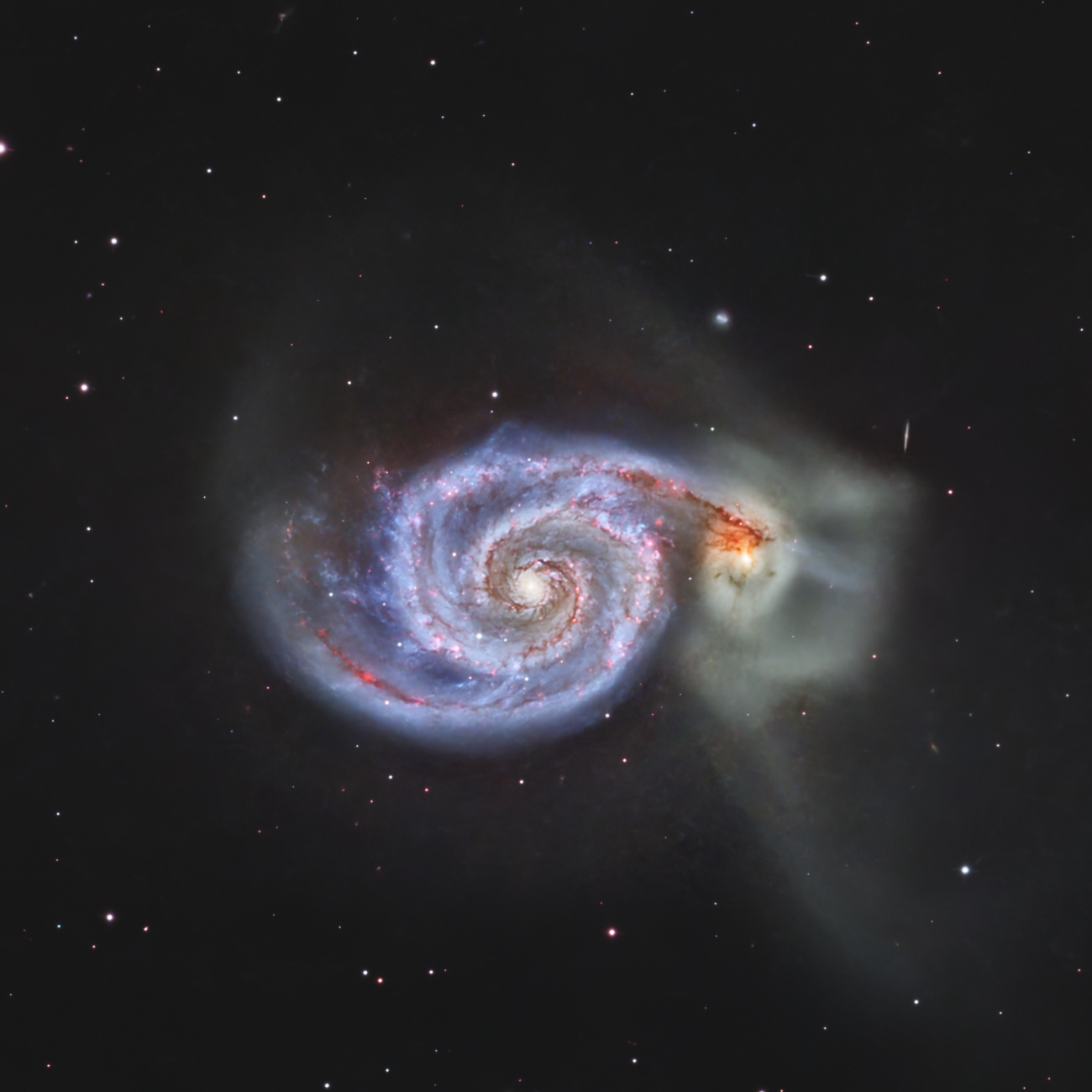
Photo: Mikko Jokela
So, we suggest trying to find:
- M51 (8.0m) is a well-known pair of interacting Whirlpool galaxies located in the constellation of the Canes Venatici. Experienced observers can see its spiral structure in dark skies.
- M94 (8.2m) is the famous Cat’s Eye galaxy, also in the constellation of the Canes Venatici.
- M101 (7.9m) is the Pinwheel Galaxy in the constellation Ursa Major.
- Clusters of galaxies in Virgo, the brightest of which are the elliptical galaxies M49, M87, M60, and M86.


